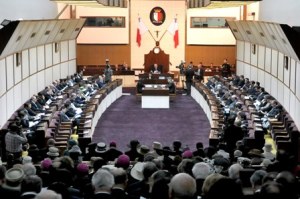published Saturday April 16, 2011
The Fukushima nuclear disaster occurred as a result of the tsunami. The earthquake measuring 9.0 on the Richter scale did not cause any direct damage to the nuclear installation.
The Fukushima nuclear reactor was (according to various reports) designed after taking into consideration the frequency and strength of earthquakes and tsunamis in the region. The strength of the earthquake and the impacts of the tsunami were substantially more than what was taken into consideration at the drawing board. The point at issue is whether, in view of the possible (and eventual) impacts resulting from a failure of the reactor’s cooling systems, the risk taken as a result of the design assumptions was justified.
After the Fukushima happenings, German Chancellor Angela Merkel changed her opinion on nuclear energy turning around 180 degrees in the space of a few months.
The European Commissioner for Energy, Günther Oettinger, former CDU Minister President of the German land of Baden-Württemberg, stated in an interview with Der Spiegel International that “Fukushima has made me start to doubt”. He added: “when Chernobyl happened, we in the west were comforted by the fact that it was the result of outdated Soviet technology and human error. But I have nothing but respect for Japan’s abilities when it comes to industry and technology. That’s why Fukushima has been such a turning point for me. It has made me start to doubt. If the Japanese cannot master this technology, then nuclear energy conceals risks I didn’t see before.”
That says it all. The Fukushima nuclear incident is the direct result of the “risk society”, which acts on the basis of the probability of a particular event happening.
Notwithstanding advances in technology and human knowledge, there will always be an unresolved element of risk when adopting technological solutions to cater for human needs. The risk can be reduced but it will never be eliminated. As Dr Oettinger himself states, at the end of the day, in the case of a nuclear power plant, faced with the residual risk, “either you accept this residual risk or you shut down”.
To date, various governments took the risk. After Fukushima, a number are coming to their senses and are adopting the option to shut down. After the recent thrashing at the polls, Chancellor Merkel’s CDU too has changed course and has reluctantly started moving towards adopting a “green” nuclear policy!
There have been four major nuclear disasters since the late 1950s. The first took place in Windscale UK in 1957; the second at Harrisburg US (Three Mile Island) in 1979; the third occurred at Chernobyl, Ukraine in 1986 and Fukushima was the fourth.
In addition to the above, there have been a countless number of other “small” incidents and a number of near misses. In France alone there are about 700 minor incidents every year, most of which go unreported.
Kenzaburo Oe is a Japanese Nobel Laureate having received the Nobel Prize for Literature in 1995. In an essay published in the New Yorker on March 28, entitled Tokyo Postcard. History Repeats, he states that the use of nuclear energy in Japan is a betrayal of the Hiroshima victims.
He says: “Like earthquakes, tsunamis and other natural calamities, the experience of Hiroshima should be etched into human memory: it was even more dramatic a catastrophe than those natural disasters precisely because it was man-made. To repeat the error by exhibiting, through the construction of nuclear reactors, the same disrespect for human life is the worst possible betrayal of the memory of Hiroshima’s victims.”
Nuclear technology disrespects life as it has been shown time and again not only to be unsafe to use but also that it places whole regions and eco-systems at risk.
While, later this month, the 25th anniversary of the Chernobyl disaster will be commemorated it is pertinent to ask whether any lessons have been learnt. Chernobyl was considered as being an exception easily explained by the then Soviet Union’s state of technological development. Fukushima is a different kettle of fish: Japanese precision and technological knowledge is second to none.
The question, however, remains that, at the end of the day, some event that has not been given sufficient weight in design considerations happens. Be it the earthquake’s strength, a tsunami’s force or the frequency of adverse weather conditions. Engineering ethics permit this as it is accepted practice that one cannot design for all eventualities.
This is the risk society that plays games with our lives. The risk society does not consider life as being sufficiently worthy of protection. It only weighs probabilities and projects these into costs.
In this scheme of things life is worthless, hence, the validity of the observation of Kenzaburo Oe that the use of nuclear energy disrespects human life and is possibly its worst betrayal.
Nuclear energy? No thanks!








